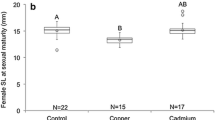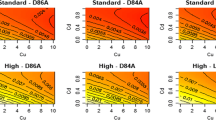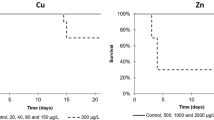Abstract
Natural and anthropogenic stressors typically do not occur in isolation; therefore, understanding ecological risk of contaminant exposure should account for potential interactions of multiple stressors. Realistically, common contaminants can also occur chronically in the environment. Because parental exposure to stressors may cause transgenerational effects on offspring, affecting their ability to cope with the same or novel environmental stressors, the exposure histories of generations preceding that being tested should be considered. To examine multiple stressor and parental exposure effects we employed a 2 × 2 × 2 factorial design in outdoor 1000-L mesocosms (n = 24). Larval southern toads (Anaxyrus terrestris), bred from parents collected from reference and metal-contaminated sites, were exposed to two levels of both an anthropogenic (copper—0, 30 µg/L Cu) and natural (predator cue − present/absent) stressor and reared to metamorphosis. Toads from the metal-contaminated parental source population were smaller at metamorphosis and had delayed development; i.e., a prolonged larval period. Similarly, larval Cu exposure also reduced size at metamorphosis and prolonged the larval period. We, additionally, observed a significant interaction between larval Cu and predator-cue exposure on larval period, wherein delayed emergence was only present in the 30-µg/L Cu treatments in the absence of predator cues. The presence of parental effects as well as an interaction between aquatic stressors on commonly measured endpoints highlight the importance of conducting multistressor studies across generations to obtain data that are more relevant to field conditions in order to determine population-level effects of contaminant exposure.





Similar content being viewed by others
References
Alford RA (2010) Declines and the global status of amphibians. In: Sparling D, Lindner G, Bishop C, Krest S (eds) Ecotoxicology of amphibians and reptiles. SETAC Press, Pensacola, pp 13–45
Ball SL, Baker RL (1996) Predator-induced life history changes: antipredator behavior costs or facultative life history shifts? Ecology 77:1116–1124
Banas D, Marin B, Skraber S, Chopin EIB, Zanella A (2010) Copper mobilization affected by weather conditions in a stormwater detention system receiving runoff waters from Vinyard soils (Champagne, France). Environ Pollut 158:476–482
Bergeron CM, Hopkins WA, Todd BD, Hepner MJ, Unrine JM (2011) Interactive effects of maternal and dietary mercury exposure have latent and lethal consequences for amphibian larvae. Environ Sci Technol 45:3781–3787
Berven KA (1990) Factors affecting population fluctuations in larval and adult stages of the wood frog (Rana sylvatica). Ecology 71:1599–1608
Bishop CA, Mahony NA, Struger J, Ng P, Pettit KE (1999) Anuran development, density and diversity in relation to agricultural activity in the Holland River watershed, Ontario, Canada (1990–1992). Environ Monit Assess 57:21–43
Boone MD, James SM (2005) Aquatic and terrestrial mesocosms in amphibian ecotoxicology. Appl Herpetol 2:231–257
Chen TH, Gross JA, Karasov WH (2007) Adverse effects of chronic copper exposure in larval northern leopard frogs (Rana pipiens). Environ Toxicol Chem 26:1470–1475
Clements WH (1999) Metal tolerance and predator–prey interactions in benthic macroinvertebrate stream communities. Ecol Appl 9:1073–1084
Costa ZJ, Vonesh JR (2013) Prey subsidy or predator cue? Direct and indirect effects of caged predators on aquatic consumers and resources. Oecologia 173:1481–1490
Defo MA, Spear PA, Couture P (2014) Consequences of metal exposure on retinoid metabolism in vertebrates: a review. Toxicol Lett 225:1–11
Flynn R, Scott D, Kuhne W, Soteropoulos D, Lance S (2015) Lethal and sublethal measures of chronic copper toxicity in the eastern narrowmouth toad, Gastrophryne carolinensis, reveal within and among population variation. Environ Sci Technol 34:575–582
García-Muñoz E, Guerrero F, Parra G (2009) Effects of copper sulfate on growth, development, and escape behavior in Epidalea calamita embryos and larvae. Arch Environ Contam Toxicol 56:557–565
Groner ML, Rollins-Smith LA, Reinert LK, Hempel J, Bier ME, Relyea RA (2014) Interactive effects of competition and predator cues on immune responses of leopard frogs at metamorphosis. J Exp Biol 217:351–358
Hanlon SM, Relyea R (2013) Sublethal effects of pesticides on predator–prey interactions in amphibians. Am Soc Ichthyol Herpetol 4:691–698
Hernández PP, Moreno V, Olivari FA, Allende ML (2006) Sub-lethal concentrations of waterborne copper are toxic to lateral line neuromasts in zebrafish (Danio rerio). Hearing Res 213:1–10
Hopkins WA, Rowe CL (2010) Interdisciplinary and hierarchical approaches for studying the effects of metals and metalloids on amphibians. In: Sparling D, Lindner G, Bishop C, Krest S (eds) Ecotoxicology of amphibians and reptiles. SETAC Press, Pensacola, pp 325–333
Hopkins WA, DuRant SE, Staub BP, Rowe CL, Jackson BP (2006) Reproduction, embryonic development, and maternal transfer of contaminants in the amphibian Gastrophryne carolinensis. Environ Health Perspect 114:661–666
Kerby JL, Hart AJ, Storfer A (2011) Combined effects of virus, pesticide, and predator cue on the larval tiger salamander (Ambystoma tigrinum). EcoHealth 8:46–54
Kimberly DA, Salice CJ (2014) If you could turn back time: understanding transgenerational latent effects of developmental exposure to contaminants. Environ Pollut 184:419–425
Lance SL, Flynn RW, Erickson MR, Scott DE (2013) Within- and among-population level differences in response to chronic copper exposure in southern toads, Anaxyrus terrestris. Environ Pollut 177:135–142
Lannoo M (ed) (2005) Amphibian Declines: the conservation status of United States species. University of California Press, Berkeley, p 1094
Lawler JJ, Shafer SL, Blaustein AR (2010) Projected climate impacts for the amphibians of the western hemisphere. Conserv Biol 24:38–50
Lefcort H, Meguire RA, Wilson LH, Ettinger WF (1998) Heavy metals alter the survival, growth, metamorphosis, and antipredatory behavior of Columbia spotted frog (Rana luteiventris) tadpoles. Arch Environ Contam Toxicol 456:447–456
Lefcort H, Wehner EA, Cocco PL (2013) Pre-exposure to heavy metal pollution and the odor of predation decrease the ability of snails to avoid stressors. Arch Environ Contam Toxicol 64:273–280
Maher JM, Werner EE, Denver RJ (2013) Stress hormones mediate predator-induced phenotypic plasticity in amphibian tadpoles. Proc R Soc B 280:20123075
Mann RM, Bidwell JR (2001) The acute toxicity of agricultural surfactants to the tadpoles of four Australian and two exotic frogs. Environ Pollut 114:195–205
Mann RM, Hyne RV, Choung CB, Wilson SP (2009) Amphibians and agricultural chemicals: review of the risks in a complex environment. Environ Pollut 157:2903–2927
McIntyre JK, Baldwin DH, Beauchamp DA, Scholz NL (2012) Low-level copper exposures increase visibility and vulnerability of juvenile coho salmon to cutthroat trout predators. Ecol Appl 22:1460–1471
Metts BS, Buhlmann KA, Scott DE, Tuberville TD, Hopkins WA (2012) Interactive effects of maternal and environmental exposure to coal combustion wastes decrease survival of larval southern toads (Bufo terrestris). Environ Pollut 164:211–218
Metts BS, Buhlmann KA, Tuberville TD, Scott DE, Hopkins WA (2013) Maternal transfer of contaminants and reduced reproductive success of southern toads (Bufo [Anaxyrus] terrestris) exposed to coal combustion waste. Environ Sci Technnol 47:2846–2853
Peles JD (2013) Effects of chronic aluminum and copper exposure on growth and development of wood frog (Rana sylvatica) larvae. Aquat Toxicol 140–141:242–248
Plautz SC, Guest T, Funkhouser MA, Salice CJ (2013) Transgenerational cross-tolerance to stress: parental exposure to predators increases offspring contaminant tolerance. Ecotoxicology 22:854–861
Pomati F, Nizzetto L (2013) Assessing triclosan-induced ecological and trans-generational effects in natural phytoplankton communities: a trait-based field method. Ecotoxicology 22:779–794
Redick MS, La Point TW (2004) Effects of sublethal copper exposure on behavior and growth of Rana pipiens tadpoles. Environ Contam Toxicol B 72:706–710
Relyea R (2006) The effects of pesticides, pH, and predatory stress on amphibians under mesocosm condidtions. Ecotoxicology 15:503–511
Relyea RA, Werner EE (1999) Quantifying the relation between predator-induced behavior and growth performance in larval anurans. Ecology 80:2117–2124
Rettig JE, Mittelbach GG (2002) Interactions between adult and larval bluegill sunfish: positive and negative effects. Oecologia 130:222–230
Reza M, Yamamoto DS, Matsuoka H (2013) Laboratory testing of larvivorous fish Japanese medaka (Oryzias latipes) predation ability to copper-treated Anopheles stephensi larvae: an alternative method for vector control under low concentration of copper. Med Entomol Zool 64:67–71
Salice CJ, Rowe CL, Pechmann JHK, Hopkins WA (2011) Multiple stressors and complex life cycles: insights from a population-level assessment of breeding site contamination and terrestrial habitat loss in an amphibian. Environ Toxicol Chem 30:2874–2882
Sandahl JF, Baldwin DH, Jenkins JJ, Scholz NL (2007) A sensory system at the interface between urban stormwater runoff and salmon survival. Environ Sci Technol 41:2998–3004
Schalles JF, Sharitz RR, Gibbons JW, Leversee GJ, Knox JN (1989) Carolina bays of the Savannah River Plant. Savannah River Plant National Environmental Research Park Program, SRO-NERP-18, 70 pp
Scott DE (1994) The effect of larval density on adult demographic traits in ambystoma. Ecology 75:1383–1396
Simpson SL, Spadaro DA, O’Brien D (2013) Incorporating bioavailability into management limits for copper in sediments contaminated by antifouling paint used in aquaculture. Chemosphere 93:2499–2506
Skelly DK (1992) Field evidence for a cost of behavioral antipredator response in a larval amphibian. Ecology 73:704–708
Sparling D, Bickham J, Cowman D, Fellers G, Lacher T, Matson C, McConnell L (2015) In situ effects of pesticides on amphibians in the Sierra Nevada. Ecotoxicology 24:262–278
Taylor BE, Scott DE (1997) Effects of larval density dependence on population dynamics of Ambystoma opacum. Herpetologica 53:132–145
Todd BD, Bergeron CM, Hepner MJ, Hopkins WA (2011) Aquatic and terrestrial stressors in amphibians: a test of the double jeopardy hypothesis based on maternally and trophically derived contaminants. Environ Toxicol Chem 30:2277–2284
Todd BD, Willson JD, Bergeron CM, Hopkins WA (2012) Do effects of mercury in larval amphibians persist after metamorphosis? Ecotoxicology 21:87–95
Wang QY, Zhou DM, Cang L (2014) Bioavailability of soil copper from different sources: integrating chemical approaches with biological indicators. Pedosphere 24:145–152
Willson JD, Hopkins WA, Bergeron CM, Todd BD (2012) Making leaps in amphibian ecotoxicology: translating individual-level effects of contaminants to population viability. Ecol Appl 22:1791–1802
Witeska M, Sarnowski P, Lugowska K, Kowal E (2014) The effects of cadmium and copper on embryonic and larval development of ide Leuciscus idus L. Fish Physiol Biochem 40:151–163
Wong NC, Wong MH, Shiu KK, Qiu JW (2006) Dependency of copper toxicity to polychaete larvae on algal concentration. Aquat Toxicol 2006:117–125
Xin Z, Wenchao Z, Yhenguang Y, Yiguo H, Zhengtao L, Xianliang Y, Xiaonan W, Tingting L, Liming Z (2015) Species sensitivity analysis of heavy metals to freshwater organisms. Ecotoxicology 24:1621–1631
Zhou Y, Zha J, Wang Z (2012) Occurrence and fate of steroid estrogens in the largest wastewater treatment plant in Beijing, China. Environ Monit Assess 184:6799–6813
Acknowledgments
We thank R. Philipps and J. Seaman for help with metals analysis. We also thank R. Beasley, A. Coleman, R.W. Flynn, C. Love, and M. Winzeler for assitance with husbandry. An earlier version of this manuscript was improved by comments by R. Bringolf, A. Davis, R. W. Flynn and two anonymous reviewers. Project funding was provided by the Department of Energy National Nuclear Security Administration. This research was partially supported by U. S. Department of Energy under Award Number DE–FC09–07SR22506 to the University of Georgia Research Foundation. This research made possible by the status of the SRS as a National Environmental Research Park (NERP), as well as the protection of research wetlands in the SRS Set-Aside Program.
Author information
Authors and Affiliations
Corresponding author
Ethics declarations
Conflict of interest
The authors declare that they have no conflict of interest.
Ethical approval
All procedures performed in studies involving animals were in accordance with ethical standards of the University of Georgia IACUC following procedures approved under AUP A2009 10-175-Y2-A0 Animals were collected under SCDNR permit #G-09-03. Informed consent was obtained from all individual participants included in the study.
Rights and permissions
About this article
Cite this article
Rumrill, C.T., Scott, D.E. & Lance, S.L. Effects of metal and predator stressors in larval southern toads (Anaxyrus terrestris). Ecotoxicology 25, 1278–1286 (2016). https://doi.org/10.1007/s10646-016-1681-3
Accepted:
Published:
Issue Date:
DOI: https://doi.org/10.1007/s10646-016-1681-3




